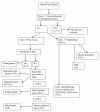Application of a diagnosis-based clinical decision guide in patients with low back pain
- PMID: 22018026
- PMCID: PMC3206436
- DOI: 10.1186/2045-709X-19-26
Application of a diagnosis-based clinical decision guide in patients with low back pain
Abstract
Background: Low back pain (LBP) is common and costly. Development of accurate and efficacious methods of diagnosis and treatment has been identified as a research priority. A diagnosis-based clinical decision guide (DBCDG; previously referred to as a diagnosis-based clinical decision rule) has been proposed which attempts to provide the clinician with a systematic, evidence-based means to apply the biopsychosocial model of care. The approach is based on three questions of diagnosis. The purpose of this study is to present the prevalence of findings using the DBCDG in consecutive patients with LBP.
Methods: Demographic, diagnostic and baseline outcome measure data were gathered on a cohort of LBP patients examined by one of three examiners trained in the application of the DBCDG.
Results: Data were gathered on 264 patients. Signs of visceral disease or potentially serious illness were found in 2.7%. Centralization signs were found in 41%, lumbar and sacroiliac segmental signs in 23% and 27%, respectively and radicular signs were found in 24%. Clinically relevant myofascial signs were diagnosed in 10%. Dynamic instability was diagnosed in 63%, fear beliefs in 40%, central pain hypersensitivity in 5%, passive coping in 3% and depression in 3%.
Conclusion: The DBCDG can be applied in a busy private practice environment. Further studies are needed to investigate clinically relevant means to identify central pain hypersensitivity, poor coping and depression, correlations and patterns among the diagnostic components of the DBCDG as well as inter-examiner reliability and efficacy of treatment based on the DBCDG.
Figures


Similar articles
-
Application of a diagnosis-based clinical decision guide in patients with neck pain.Chiropr Man Therap. 2011 Aug 27;19(1):19. doi: 10.1186/2045-709X-19-19. Chiropr Man Therap. 2011. PMID: 21871119 Free PMC article.
-
Decision making in surgical treatment of chronic low back pain: the performance of prognostic tests to select patients for lumbar spinal fusion.Acta Orthop Suppl. 2013 Feb;84(349):1-35. doi: 10.3109/17453674.2012.753565. Acta Orthop Suppl. 2013. PMID: 23427903
-
Inter-examiner reliability of a proposed decision-making treatment based classification system for low back pain patients.Man Ther. 2012 Apr;17(2):164-71. doi: 10.1016/j.math.2011.12.009. Epub 2012 Jan 20. Man Ther. 2012. PMID: 22261649
-
A modified Delphi survey on the signs and symptoms of low back pain: indicators for an interventional management approach.Pain Pract. 2015 Jan;15(1):12-21. doi: 10.1111/papr.12135. Epub 2013 Dec 9. Pain Pract. 2015. PMID: 24314001
-
Diagnostic triage for low back pain: a practical approach for primary care.Med J Aust. 2017 Apr 3;206(6):268-273. doi: 10.5694/mja16.00828. Med J Aust. 2017. PMID: 28359011 Review.
Cited by
-
An evidence-based diagnostic classification system for low back pain.J Can Chiropr Assoc. 2013 Sep;57(3):189-204. J Can Chiropr Assoc. 2013. PMID: 23997245 Free PMC article.
-
Understanding Monitoring Technologies for Adults With Pain: Systematic Literature Review.J Med Internet Res. 2017 Oct 27;19(10):e364. doi: 10.2196/jmir.7279. J Med Internet Res. 2017. PMID: 29079550 Free PMC article.
-
Measuring biopsychosocial risk for back pain disability in chiropractic patients using the STarT back screening tool: a cross-sectional survey.Chiropr Man Therap. 2019 Jan 15;27:2. doi: 10.1186/s12998-018-0228-5. eCollection 2019. Chiropr Man Therap. 2019. PMID: 30675336 Free PMC article.
-
Clinical decision rules, spinal pain classification and prediction of treatment outcome: A discussion of recent reports in the rehabilitation literature.Chiropr Man Therap. 2012 Jun 22;20(1):19. doi: 10.1186/2045-709X-20-19. Chiropr Man Therap. 2012. PMID: 22726639 Free PMC article.
-
The rationale for primary spine care employing biopsychosocial, stratified and diagnosis-based care-pathways at a chiropractic college public clinic: a literature review.Chiropr Man Therap. 2013 Jun 9;21(1):19. doi: 10.1186/2045-709X-21-19. Chiropr Man Therap. 2013. PMID: 23758900 Free PMC article.
References
-
- Deyo RA, Phillips WR. Low back pain a primary care challenge. Spine. 1996;21(24):760–765. - PubMed
LinkOut - more resources
Full Text Sources
Miscellaneous

